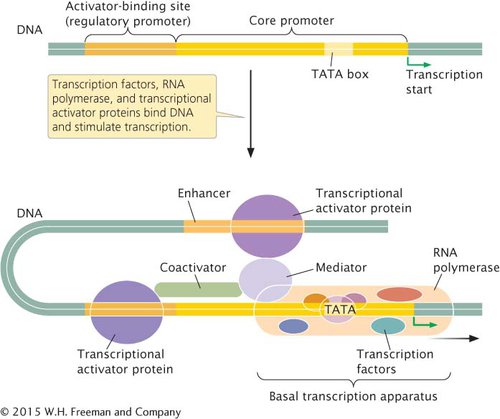Transcription Factors and Transcriptional Regulator Proteins
Transcription is an important level of control in eukaryotic cells, and this control requires a number of different types of proteins and regulatory elements. Eukaryotic promoters for genes that encode proteins consist of two parts: a core promoter, which is located immediately upstream of the gene, and a regulatory promoter, which lies upstream of the core promoter. Proteins called general transcription factors and RNA polymerase assemble into a basal transcription apparatus, which binds to a core promoter. The basal transcription apparatus is capable of minimal levels of transcription, but transcriptional regulator proteins are required to bring about normal levels of transcription. These proteins bind to the regulatory promoter and affect the levels of transcription that take place (Figure 12.16). Transcriptional regulator proteins also bind to enhancers, which are regulatory elements that may be located some distance from the gene. The exact position and orientation of an enhancer in relation to the promoter it affects can vary. Some transcriptional regulator proteins are activators; others are repressors.

TRANSCRIPTIONAL ACTIVATORS AND REPRESSORS Transcriptional activator proteins stimulate and stabilize the basal transcription apparatus at the core promoter. The activators may interact directly with the basal transcription apparatus or indirectly through protein coactivators. Some activators and coactivators, as well as general transcription factors, also have acetyltransferase activity and so further stimulate transcription by altering chromatin structure. Some regulatory proteins in eukaryotic cells act as repressors, inhibiting transcription. These repressors bind to sequences in the regulatory promoter or to silencers. Silencers, like enhancers, affect transcription at distant promoters and are position and orientation independent. Unlike repressors in bacteria, most eukaryotic repressors do not directly block RNA polymerase. These repressors may compete with transcriptional activators for DNA binding sites: when a site is occupied by an activator, transcription is activated, but if a repressor occupies that site, there is no activation. Alternatively, a repressor may bind to sites near an activator-
326
Within the regulatory promoter are typically several different consensus sequences to which different transcriptional activators and repressors can bind. Among different promoters, these binding sites are mixed and matched in different combinations (Figure 12.17), so each promoter is regulated by a unique combination of transcriptional activator and repressor proteins.

CONCEPTS
Transcriptional regulator proteins in eukaryotic cells can influence the initiation of transcription by affecting the stability or assembly of the basal transcription apparatus. Some transcriptional regulator proteins are activators that stimulate transcription; others are repressors that inhibit the initiation of transcription.
 CONCEPT CHECK 7
CONCEPT CHECK 7
Most transcriptional activator proteins affect transcription by interacting with
introns.
the basal transcription apparatus.
DNA polymerase.
nucleosomes.
b
ENHANCERS AND INSULATORS Enhancers are capable of affecting transcription at distant promoters. For example, an enhancer that regulates the gene encoding the alpha chain of the T-
Recent research demonstrates that many enhancers are themselves transcribed into short RNA molecules called enhancer RNAs (eRNAs). Evidence suggests that transcription of enhancers is often associated with transcription at the promoters that the enhancers affect. How transcription at the enhancer might affect transcription occurring at a distant promoter is not clear. The enhancer might recruit RNA polymerase, which might then be transferred to the promoter when the enhancer interacts with the promoter. Alternatively, transcription of the enhancer might allow the chromatin to adopt a more open configuration, which would then facilitate transcription at nearby promoters.
Most enhancers are capable of stimulating any promoter in their vicinities. Their effects are limited, however, by insulators (also called boundary elements), which are DNA sequences that block or insulate the effects of enhancers in a position- TRY PROBLEM 34
TRY PROBLEM 34
327

CONCEPTS
Some regulatory proteins bind to enhancers, which are regulatory elements that are distant from the gene for which they stimulate transcription. Insulators are DNA sequences that block the action of enhancers.
 CONCEPT CHECK 8
CONCEPT CHECK 8
How does the binding of regulatory proteins to enhancers affect transcription at genes that are thousands of base pairs away?
The DNA between the enhancer and the promoter loops out, so that transcription activators bound to the enhancer are able to interact directly with the basal transcription apparatus.
COORDINATED GENE REGULATION Although most eukaryotic cells do not possess operons, several eukaryotic genes may be activated by the same stimulus. For example, many eukaryotic cells respond to extreme heat and other stresses by producing heat-
Genes that are coordinately expressed in eukaryotic cells are able to respond to the same stimulus because they share short regulatory sequences in their promoters or enhancers. For example, different eukaryotic heat-